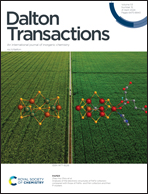Hydrophobic functionalization of a metal–organic framework as an ammonia visual sensing material under high humidity conditions†
Abstract
Since exhaled ammonia (NH3) is one of the metabolic markers of liver and kidney diseases, ammonia visual sensing materials in humid environments have received extensive attention and investigation. Herein, through a tailor-made pore environment provided by metal–organic framework (MOF) materials (CH3-Cu(BDC)), we achieved NH3 anti-interference sensing with apparent color changing under humid conditions. With methyl (CH3–) functionalization, CH3-Cu(BDC) demonstrated a strong response for trace ammonia and showed high selectivity under a humid environment. Grand canonical Monte Carlo (GCMC) simulations indicated that CH3-Cu(BDC) showed stronger attraction towards NH3 molecules than H2O. Benefiting from the target changing coordination environment, CH3-Cu(BDC) showed a rapid response and simple analysis properties for patients’ exhaled air. The strategy used in this study not only provides a demonstration case for NH3 colorimetric sensing with high humidity and anti-interference but also introduces a new method for painless and quick exhaled breath analysis for diagnosis of patients with kidney and liver diseases.



 Please wait while we load your content...
Please wait while we load your content...